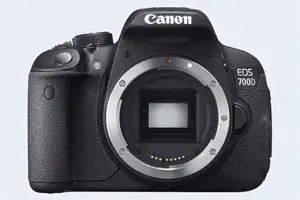Canon 700D vs SX60
The Canon EOS 700D (called Canon T5i in some regions) and the Canon PowerShot SX60 HS are two digital cameras that were officially introduced, respectively, in March 2013 and September 2014. The 700D is a DSLR, while the SX60 is a fixed lens compact. The cameras are based on an APS-C (700D) and a 1/2.3-inch (SX60) sensor. The 700D has a resolution of 17.9 megapixels, whereas the SX60 provides 14.2 MP.
Below is an overview of the main specs of the two cameras as a starting point for the comparison.

Check 700D offers at
ebay.com

Check SX60 offers at
ebay.com
Going beyond this snapshot of core features and characteristics, what are the differences between the Canon EOS 700D and the Canon PowerShot SX60 HS? Which one should you buy? Read on to find out how these two cameras compare with respect to their body size, their imaging sensors, their shooting features, their input-output connections, and their reception by expert reviewers.
Body comparison
The side-by-side display below illustrates the physical size and weight of the Canon 700D and the Canon SX60. The two cameras are presented according to their relative size. Three successive views from the front, the top, and the rear are shown. All width, height and depth dimensions are rounded to the nearest millimeter.
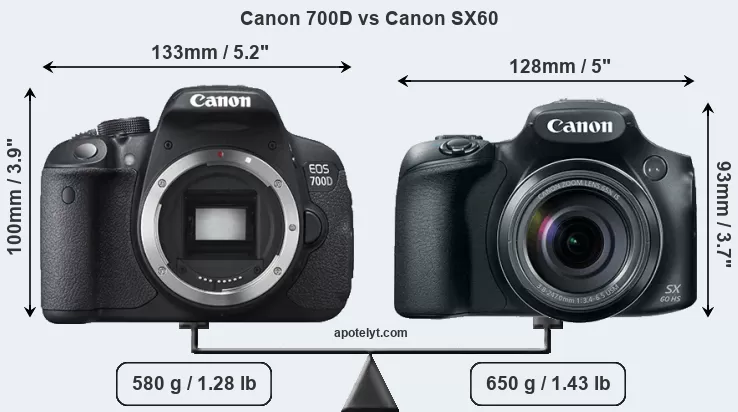
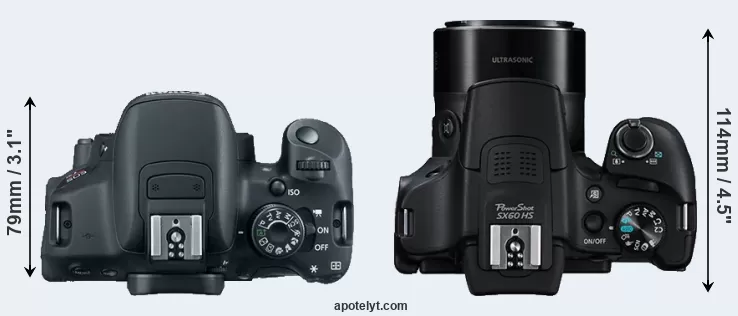
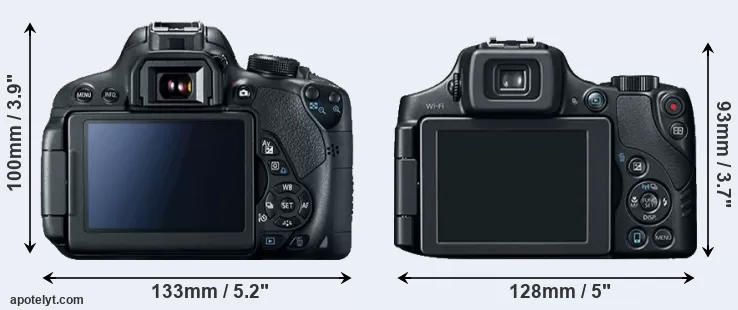
If the front view area (width x height) of the cameras is taken as an aggregate measure of their size, the Canon SX60 is notably smaller (10 percent) than the Canon 700D. In this context, it is worth noting that neither the 700D nor the SX60 are weather-sealed.
The above size and weight comparisons are to some extent incomplete and possibly misleading, as the SX60 has a lens built in, whereas the 700D is an interchangeable lens camera that requires a separate lens. Attaching the latter will add extra weight and bulk to the setup. You can compare the optics available for the 700D and their specifications in the Canon EF Lens Catalog.
Concerning battery life, the 700D gets 440 shots out of its Canon LP-E8 battery, while the SX60 can take 340 images on a single charge of its Canon NB-10L power pack.
The following table provides a synthesis of the main physical specifications of the two cameras and other similar ones. In case you want to display and compare another camera duo, you can use the CAM-parator app to select your camera combination among a large number of options.

| Camera Model |
Camera Width |
Camera Height |
Camera Depth |
Camera Weight |
Battery Life |
Weather Sealing |
Camera Launch |
Launch Price (USD) |
Street Price |
||
|---|---|---|---|---|---|---|---|---|---|---|---|
| 1. | Canon 700D | 133 mm | 100 mm | 79 mm | 580 g | 440 | n | Mar 2013 | 649 | ebay.com | |
| 2. | Canon SX60 | 128 mm | 93 mm | 114 mm | 650 g | 340 | n | Sep 2014 | 549 | ebay.com | |
| 3. | Canon 100D | 117 mm | 91 mm | 69 mm | 407 g | 380 | n | Mar 2013 | 549 | ebay.com | |
| 4. | Canon 500D | 129 mm | 98 mm | 62 mm | 520 g | 400 | n | Mar 2009 | 799 | ebay.com | |
| 5. | Canon 550D | 129 mm | 98 mm | 62 mm | 530 g | 440 | n | Feb 2010 | 699 | ebay.com | |
| 6. | Canon 600D | 133 mm | 100 mm | 80 mm | 570 g | 440 | n | Feb 2011 | 599 | ebay.com | |
| 7. | Canon 650D | 133 mm | 100 mm | 79 mm | 575 g | 440 | n | Jun 2012 | 849 | ebay.com | |
| 8. | Canon 750D | 132 mm | 101 mm | 78 mm | 555 g | 440 | n | Feb 2015 | 749 | ebay.com | |
| 9. | Canon 760D | 132 mm | 101 mm | 78 mm | 565 g | 440 | n | Feb 2015 | 649 | ebay.com | |
| 10. | Canon 1200D | 130 mm | 100 mm | 78 mm | 480 g | 500 | n | Feb 2014 | 449 | ebay.com | |
| 11. | Canon G1 X Mark II | 116 mm | 74 mm | 66 mm | 553 g | 240 | n | Feb 2014 | 799 | ebay.com | |
| 12. | Canon G7 X | 103 mm | 60 mm | 40 mm | 304 g | 210 | n | Sep 2014 | 699 | ebay.com | |
| 13. | Canon G16 | 109 mm | 76 mm | 40 mm | 356 g | 360 | n | Aug 2013 | 549 | ebay.com | |
| 14. | Canon M | 109 mm | 66 mm | 32 mm | 298 g | 230 | n | Jul 2012 | 599 | ebay.com | |
| 15. | Canon SX50 | 123 mm | 87 mm | 106 mm | 595 g | 315 | n | Sep 2012 | 429 | ebay.com | |
| 16. | Canon SX70 | 127 mm | 91 mm | 117 mm | 608 g | 325 | n | Sep 2018 | 549 | amazon.com | |
| 17. | Panasonic FZ300 | 132 mm | 92 mm | 117 mm | 691 g | 380 | Y | Jul 2015 | 599 | amazon.com | |
| Note: Measurements and pricing do not include easily detachable parts, such as add-on or interchangeable lenses or optional viewfinders. | |||||||||||
Any camera decision will naturally be influenced heavily by the price. The listed launch prices provide an indication of the market segment that the manufacturer of the cameras have been targeting. The SX60 was launched at a lower price than the 700D, despite having a lens built in. Usually, retail prices stay at first close to the launch price, but after several months, discounts become available. Later in the product cycle and, in particular, when the replacement model is about to appear, further discounting and stock clearance sales often push the camera price considerably down.
Sensor comparison
The size of the imaging sensor is a crucial determinant of image quality. A large sensor will generally have larger individual pixels that offer better low-light sensitivity, provide wider dynamic range, and have richer color-depth than smaller pixels in a sensor of the same technological generation. Moreover, a large sensor camera will give the photographer more control over depth-of-field in the image and, thus, the ability to better isolate a subject from the background. On the downside, larger sensors are more costly to manufacture and tend to lead to bigger and heavier cameras and lenses.
Of the two cameras under consideration, the Canon 700D features an APS-C sensor and the Canon SX60 a 1/2.3-inch sensor. The sensor area in the SX60 is 92 percent smaller. As a result of these sensor size differences, the cameras have a format factor of, respectively, 1.6 and 5.6. The sensor in the 700D has a native 3:2 aspect ratio, while the one in the SX60 offers a 4:3 aspect.
Technology-wise, the SX60 uses a more advanced image processing engine (DIGIC 6) than the 700D (DIGIC 5), with benefits for noise reduction, color accuracy, and processing speed.
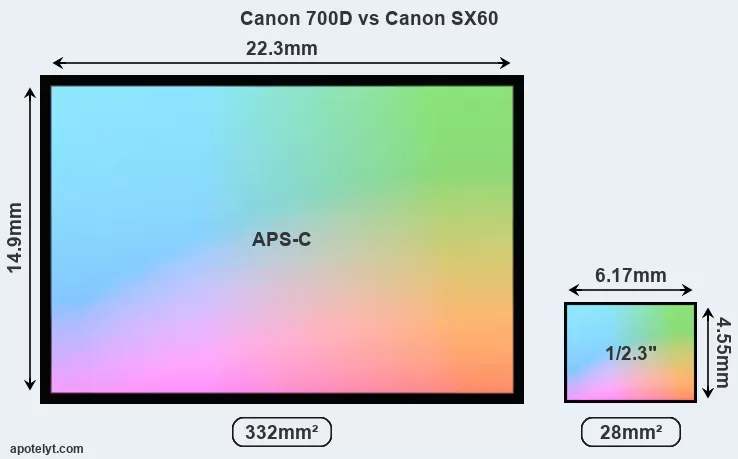
With 17.9MP, the 700D offers a higher resolution than the SX60 (14.2MP), but the 700D nevertheless has larger individual pixels (pixel pitch of 4.31μm versus 1.40μm for the SX60) due to its larger sensor. However, the SX60 is a somewhat more recent model (by 1 year and 5 months) than the 700D, and its sensor might have benefitted from technological advances during this time that enhance the light gathering capacity of its pixels. Coming back to sensor resolution, it should be mentioned that the SX60 has no anti-alias filter installed, so that it can capture all the detail its sensor resolves.
The resolution advantage of the Canon 700D implies greater flexibility for cropping images or the possibility to print larger pictures. The maximum print size of the 700D for good quality output (200 dots per inch) amounts to 25.9 x 17.3 inches or 65.8 x 43.9 cm, for very good quality (250 dpi) 20.7 x 13.8 inches or 52.7 x 35.1 cm, and for excellent quality (300 dpi) 17.3 x 11.5 inches or 43.9 x 29.3 cm. The corresponding values for the Canon SX60 are 23 x 15.4 inches or 58.5 x 39 cm for good quality, 18.4 x 12.3 inches or 46.8 x 31.2 cm for very good quality, and 15.4 x 10.2 inches or 39 x 26 cm for excellent quality prints.
The 700D has on-sensor phase detect pixels, which results in fast and reliable autofocus acquisition even during live view operation.
The Canon EOS 700D has a native sensitivity range from ISO 100 to ISO 12800, which can be extended to ISO 100-25600. The corresponding ISO settings for the Canon PowerShot SX60 HS are ISO 100 to ISO 3200, with the possibility to increase the ISO range to 100-6400.
In terms of underlying technology, the 700D is build around a CMOS sensor, while the SX60 uses a BSI-CMOS imager. Both cameras use a Bayer filter for capturing RGB colors on a square grid of photosensors. This arrangement is found in most digital cameras.
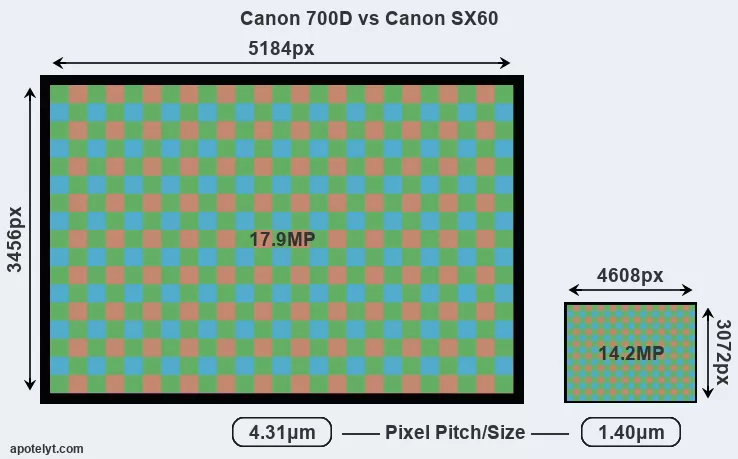
Consistent information on actual sensor performance is available from DXO Mark for many cameras. This service determines an overall sensor rating, as well as sub-scores for low-light sensitivity ("DXO Sports"), dynamic range ("DXO Landscape"), and color depth ("DXO Portrait"). Of the two cameras under review, the 700D provides substantially higher image quality than the SX60, with an overall score that is 22 points higher. This advantage is based on 2.5 bits higher color depth, 0.4 EV in additional dynamic range, and 2.4 stops in additional low light sensitivity. The following table provides an overview of the physical sensor characteristics, as well as the sensor quality measurements for a selection of comparators.

| Camera Model |
Sensor Class |
Resolution (MP) |
Horiz. Pixels |
Vert. Pixels |
Video Format |
DXO Portrait |
DXO Landscape |
DXO Sports |
DXO Overall |
||
|---|---|---|---|---|---|---|---|---|---|---|---|
| 1. | Canon 700D | APS-C | 17.9 | 5184 | 3456 | 1080/30p | 21.7 | 11.2 | 681 | 61 | |
| 2. | Canon SX60 | 1/2.3 | 14.2 | 4608 | 3072 | 1080/60p | 19.2 | 10.8 | 127 | 39 | |
| 3. | Canon 100D | APS-C | 17.9 | 5184 | 3456 | 1080/30p | 21.8 | 11.3 | 843 | 63 | |
| 4. | Canon 500D | APS-C | 15.1 | 4752 | 3168 | 1080/20p | 21.7 | 11.5 | 663 | 63 | |
| 5. | Canon 550D | APS-C | 17.9 | 5184 | 3456 | 1080/30p | 22.1 | 11.5 | 784 | 66 | |
| 6. | Canon 600D | APS-C | 17.9 | 5184 | 3456 | 1080/30p | 22.1 | 11.5 | 793 | 65 | |
| 7. | Canon 650D | APS-C | 17.9 | 5184 | 3456 | 1080/30p | 21.7 | 11.2 | 722 | 62 | |
| 8. | Canon 750D | APS-C | 24.0 | 6000 | 4000 | 1080/30p | 22.7 | 12.0 | 919 | 71 | |
| 9. | Canon 760D | APS-C | 24.0 | 6000 | 4000 | 1080/30p | 22.6 | 12.0 | 915 | 70 | |
| 10. | Canon 1200D | APS-C | 17.9 | 5184 | 3456 | 1080/30p | 21.9 | 11.3 | 724 | 63 | |
| 11. | Canon G1 X Mark II | 1.5-inch | 13.0 | 4160 | 3120 | 1080/30p | 21.5 | 10.8 | 581 | 58 | |
| 12. | Canon G7 X | 1-inch | 20.0 | 5472 | 3648 | 1080/60p | 23.0 | 12.7 | 556 | 71 | |
| 13. | Canon G16 | 1/1.7 | 12.0 | 4000 | 3000 | 1080/60p | 21.0 | 11.7 | 230 | 54 | |
| 14. | Canon M | APS-C | 17.9 | 5184 | 3456 | 1080/30p | 22.1 | 11.2 | 827 | 65 | |
| 15. | Canon SX50 | 1/2.3 | 12.0 | 4000 | 3000 | 1080/24p | 20.3 | 11.2 | 179 | 47 | |
| 16. | Canon SX70 | 1/2.3 | 20.2 | 5184 | 3888 | 4K/30p | 20.6 | 12.1 | 1063 | 51 | |
| 17. | Panasonic FZ300 | 1/2.3 | 12.0 | 4000 | 3000 | 4K/30p | 19.3 | 11.0 | 97 | 38 | |
| Note: DXO values in italics represent estimates based on sensor size and age. | |||||||||||
Many modern cameras are not only capable of taking still images, but also of capturing video footage. Both cameras under consideration have a sensor with sufficiently fast read-out times for moving pictures, but the SX60 provides a faster frame rate than the 700D. It can shoot movie footage at 1080/60p, while the 700D is limited to 1080/30p.
Feature comparison
Apart from body and sensor, cameras can and do differ across a range of features. For example, the SX60 has an electronic viewfinder (922k dots), while the 700D has an optical one. Both systems have their advantages, with the electronic viewfinder making it possible to project supplementary shooting information into the framing view, whereas the optical viewfinder offers lag-free viewing and a very clear framing image. The following table reports on some other key feature differences and similarities of the Canon 700D, the Canon SX60, and comparable cameras.

| Camera Model |
Viewfinder (Type or 000 dots) |
Control Panel (yes/no) |
LCD Specifications (inch/000 dots) |
LCD Attach- ment |
Touch Screen (yes/no) |
Max Shutter Speed * |
Max Shutter Flaps * |
Built-in Flash (yes/no) |
Built-in Image Stab |
||
|---|---|---|---|---|---|---|---|---|---|---|---|
| 1. | Canon 700D | optical | n | 3.0 / 1040 | swivel | Y | 1/4000s | 5.0/s | Y | n | |
| 2. | Canon SX60 | 922 | n | 3.0 / 922 | swivel | n | 1/2000s | 6.4/s | Y | Y | |
| 3. | Canon 100D | optical | n | 3.0 / 1040 | fixed | Y | 1/4000s | 4.9/s | Y | n | |
| 4. | Canon 500D | optical | n | 3.0 / 920 | fixed | n | 1/4000s | 3.4/s | Y | n | |
| 5. | Canon 550D | optical | n | 3.0 / 1040 | fixed | n | 1/4000s | 3.7/s | Y | n | |
| 6. | Canon 600D | optical | n | 3.0 / 1040 | swivel | n | 1/4000s | 3.7/s | Y | n | |
| 7. | Canon 650D | optical | n | 3.0 / 1040 | swivel | Y | 1/4000s | 5.0/s | Y | n | |
| 8. | Canon 750D | optical | n | 3.0 / 1040 | swivel | Y | 1/4000s | 5.0/s | Y | n | |
| 9. | Canon 760D | optical | Y | 3.0 / 1040 | swivel | Y | 1/4000s | 5.0/s | Y | n | |
| 10. | Canon 1200D | optical | n | 3.0 / 460 | fixed | n | 1/4000s | 3.0/s | Y | n | |
| 11. | Canon G1 X Mark II | optional | n | 3.0 / 1040 | tilting | Y | 1/4000s | 5.2/s | Y | Y | |
| 12. | Canon G7 X | none | n | 3.0 / 1040 | tilting | Y | 1/2000s | 6.5/s | Y | Y | |
| 13. | Canon G16 | optical | n | 3.0 / 922 | fixed | n | 1/4000s | 2.2/s | Y | Y | |
| 14. | Canon M | none | n | 3.0 / 1040 | fixed | Y | 1/4000s | 4.3/s | n | n | |
| 15. | Canon SX50 | 202 | n | 3.0 / 461 | swivel | n | 1/2000s | 2.2/s | Y | Y | |
| 16. | Canon SX70 | 2360 | n | 3.0 / 922 | swivel | n | 1/2000s | 10.0/s | Y | Y | |
| 17. | Panasonic FZ300 | 1440 | n | 3.0 / 1040 | swivel | Y | 1/4000s | 12.0/s | Y | Y | |
| Note: *) Information refers to the mechanical shutter, unless the camera only has an electronic one. | |||||||||||
One differentiating feature between the two cameras concerns the touch sensitivity of the rear screen. The 700D has a touchscreen, while the SX60 has a conventional panel. Touch control can be particularly helpful, for example, for setting the focus point.
Both cameras have an articulated rear screen that can be turned to be front-facing. This feature will be particularly appreciated by vloggers and photographers who are interested in taking selfies.Concerning the storage of imaging data, both the 700D and the SX60 write their files to SDXC cards. The 700D supports UHS-I cards (Ultra High Speed data transfer of up to 104 MB/s), while the SX60 cannot take advantage of Ultra High Speed SD cards.
Connectivity comparison
For some imaging applications, the extent to which a camera can communicate with its environment can be an important aspect in the camera decision process. The table below provides an overview of the connectivity of the Canon EOS 700D and Canon PowerShot SX60 HS and, in particular, the interfaces the cameras (and selected comparators) provide for accessory control and data transfer.

| Camera Model |
Hotshoe Port |
Internal Mic / Speaker |
Microphone Port |
Headphone Port |
HDMI Port |
USB Port |
WiFi Support |
NFC Support |
Bluetooth Support |
||
|---|---|---|---|---|---|---|---|---|---|---|---|
| 1. | Canon 700D | Y | stereo / mono | Y | - | mini | 2.0 | - | - | - | |
| 2. | Canon SX60 | Y | stereo / mono | Y | - | mini | 2.0 | Y | Y | - | |
| 3. | Canon 100D | Y | mono / mono | Y | - | mini | 2.0 | - | - | - | |
| 4. | Canon 500D | Y | mono / mono | - | - | mini | 2.0 | - | - | - | |
| 5. | Canon 550D | Y | stereo / - | Y | - | mini | 2.0 | - | - | - | |
| 6. | Canon 600D | Y | mono / mono | Y | - | mini | 2.0 | - | - | - | |
| 7. | Canon 650D | Y | stereo / mono | Y | - | mini | 2.0 | - | - | - | |
| 8. | Canon 750D | Y | stereo / mono | Y | - | mini | 2.0 | Y | Y | - | |
| 9. | Canon 760D | Y | stereo / mono | Y | - | mini | 2.0 | Y | Y | - | |
| 10. | Canon 1200D | Y | mono / mono | - | - | mini | 2.0 | - | - | - | |
| 11. | Canon G1 X Mark II | Y | stereo / mono | - | - | mini | 2.0 | Y | Y | - | |
| 12. | Canon G7 X | - | stereo / mono | - | - | micro | 2.0 | Y | Y | - | |
| 13. | Canon G16 | Y | stereo / mono | - | - | mini | 2.0 | Y | - | - | |
| 14. | Canon M | Y | stereo / mono | Y | - | mini | 2.0 | - | - | - | |
| 15. | Canon SX50 | Y | stereo / mono | - | - | mini | 2.0 | - | - | - | |
| 16. | Canon SX70 | - | stereo / mono | Y | - | micro | 2.0 | Y | - | Y | |
| 17. | Panasonic FZ300 | Y | stereo / mono | Y | - | mini | 2.0 | Y | - | - |
It is notable that the SX60 offers wifi support, which can be a very convenient means to transfer image data to an off-camera location. In contrast, the 700D does not provide wifi capability.
Both the 700D and the SX60 have been discontinued, but can regularly be found used on ebay. The 700D was replaced by the Canon 750D, while the SX60 was followed by the Canon SX70. Further information on the features and operation of the 700D and SX60 can be found, respectively, in the Canon 700D Manual (free pdf) or the online Canon SX60 Manual.
Review summary
So what conclusions can be drawn? Which of the two cameras – the Canon 700D or the Canon SX60 – has the upper hand? Is one clearly better than the other? Below is a summary of the relative strengths of each of the two contestants.
Reasons to prefer the Canon EOS 700D:
- More detail: Offers more megapixels (17.9 vs 14.2MP) with a 12% higher linear resolution.
- Better moiré control: Has an anti-alias filter to avoid artificial patterns to appear in images.
- Better image quality: Scores substantially higher (22 points) in the DXO overall assessment.
- Richer colors: Generates images with noticeably better colors (2.5 bits more color depth).
- Better low-light sensitivity: Requires less light for good images (2.4 stops ISO advantage).
- Better live-view autofocus: Features on-sensor phase-detection for more confident autofocus.
- Brighter framing: Features an optical viewfinder for clear, lag-free composition.
- More detailed LCD: Has a higher resolution rear screen (1040k vs 922k dots).
- Fewer buttons to press: Is equipped with a touch-sensitive rear screen to facilitate handling.
- Faster shutter: Has higher mechanical shutter speed (1/4000s vs 1/2000s) to freeze action.
- More flexible: Can take a variety of interchangeable lenses, including specialty optics.
- Longer lasting: Can take more shots (440 versus 340) on a single battery charge.
- Faster buffer clearing: Has an SD card interface that supports the UHS-I standard.
- More heavily discounted: Has been on the market for longer (launched in March 2013).
Arguments in favor of the Canon PowerShot SX60 HS:
- Maximized detail: Lacks an anti-alias filter to exploit the sensor's full resolution potential.
- Better jpgs: Has a more modern image processing engine (DIGIC 6 vs DIGIC 5).
- Better video: Provides higher movie framerates (1080/60p versus 1080/30p).
- More framing info: Has an electronic viewfinder that displays shooting data.
- Faster burst: Shoots at higher frequency (6.4 vs 5 flaps/sec) to capture the decisive moment.
- Ready to shoot: Comes with an integrated lens, while the 700D requires a separate lens.
- More compact: Is smaller (128x93mm vs 133x100mm) and will fit more readily into a bag.
- Sharper images: Has stabilization technology built-in to reduce the impact of hand-shake.
- Easier file upload: Has wifi built in for automatic backup or image transfer to the web.
- Easier device pairing: Supports NFC for fast wireless image transfer over short distances.
- More affordable: Was introduced at a lower price, despite coming with a built-in lens.
- More modern: Was introduced somewhat (1 year and 5 months) more recently.
If the number of relative strengths (bullet points above) is taken as a guide, the 700D emerges as the winner of the contest (14 : 12 points). However, the relevance of individual strengths will vary across photographers, so that you might want to apply your own weighing scheme to the summary points when reflecting and deciding on a new camera. A professional wildlife photographer will view the differences between cameras in a way that diverges from the perspective of a family photog, and a person interested in architecture has distinct needs from a sports shooter. Hence, the decision which camera is best and worth buying is often a very personal one.
How about other alternatives? Do the specifications of the Canon 700D and the Canon SX60 place the cameras among the top in their class? Find out in the latest Best DSLR Camera and Best Superzoom Camera listings whether the two cameras rank among the cream of the crop.
In any case, while the specs-based evaluation of cameras can be instructive in revealing their potential as photographic tools, it remains partial and cannot reveal, for example, the shooting experience and imaging performance when actually working with the 700D or the SX60. At times, user reviews, such as those published at amazon, address these issues in a useful manner, but such feedback is on many occasions incomplete, inconsistent, and unreliable.
Expert reviews
This is why expert reviews are important. The table below provides a synthesis of the camera assessments of some of the best known photo-gear review sites (amateurphotographer [AP], cameralabs [CL], digitalcameraworld [DCW], dpreview [DPR], ephotozine [EPZ], photographyblog [PB]). As can be seen, the professional reviewers agree in many cases on the quality of different cameras, but sometimes their assessments diverge, reinforcing the earlier point that a camera decision is often a very personal choice.

| Camera Model |
AP score |
CL score |
DCW score |
DPR score |
EPZ score |
PB score |
Camera Launch |
Launch Price (USD) |
Street Price |
||
|---|---|---|---|---|---|---|---|---|---|---|---|
| 1. | Canon 700D | .. | .. | .. | 76/100 | 4.5/5 | 4.5/5 | Mar 2013 | 649 | ebay.com | |
| 2. | Canon SX60 | 3/5 | + + | .. | 75/100 | 4/5 | 4.5/5 | Sep 2014 | 549 | ebay.com | |
| 3. | Canon 100D | 4/5 | + | .. | 78/100 | 4/5 | 4/5 | Mar 2013 | 549 | ebay.com | |
| 4. | Canon 500D | .. | + + | .. | 74/100 | 4.5/5 | 4.5/5 | Mar 2009 | 799 | ebay.com | |
| 5. | Canon 550D | .. | + + | .. | 77/100 | 4/5 | 4.5/5 | Feb 2010 | 699 | ebay.com | |
| 6. | Canon 600D | 3/5 | o | .. | 77/100 | 4.5/5 | 4.5/5 | Feb 2011 | 599 | ebay.com | |
| 7. | Canon 650D | 4/5 | + + | .. | 77/100 | 4.5/5 | 4.5/5 | Jun 2012 | 849 | ebay.com | |
| 8. | Canon 750D | 5/5 | .. | .. | 75/100 | 4.5/5 | 4.5/5 | Feb 2015 | 749 | ebay.com | |
| 9. | Canon 760D | 5/5 | + | .. | 77/100 | 4.5/5 | 4.5/5 | Feb 2015 | 649 | ebay.com | |
| 10. | Canon 1200D | 3/5 | + | .. | .. | 4/5 | 4.5/5 | Feb 2014 | 449 | ebay.com | |
| 11. | Canon G1 X Mark II | 3/5 | + | .. | 77/100 | 4/5 | 4.5/5 | Feb 2014 | 799 | ebay.com | |
| 12. | Canon G7 X | 4/5 | + + | .. | 77/100 | 4.5/5 | 4.5/5 | Sep 2014 | 699 | ebay.com | |
| 13. | Canon G16 | 4/5 | + | .. | .. | 4.5/5 | 4.5/5 | Aug 2013 | 549 | ebay.com | |
| 14. | Canon M | 3/5 | + | .. | .. | 4/5 | 4/5 | Jul 2012 | 599 | ebay.com | |
| 15. | Canon SX50 | 3/5 | + + | .. | 72/100 | 4.5/5 | 4.5/5 | Sep 2012 | 429 | ebay.com | |
| 16. | Canon SX70 | .. | + + | 3.5/5 | .. | 3.5/5 | 3.5/5 | Sep 2018 | 549 | amazon.com | |
| 17. | Panasonic FZ300 | .. | + + | .. | .. | 4.5/5 | 4.5/5 | Jul 2015 | 599 | amazon.com | |
| Note: (+ +) highly recommended; (+) recommended; (o) reviewed; (..) not available. | |||||||||||
Care should be taken when interpreting the review scores above, though. The ratings were established in reference to similarly priced cameras that were available in the market at the time of the review. Hence, a score should always be seen in the context of the camera's market launch date and its price, and comparing ratings of very distinct cameras or ones that are far apart in terms of their release date have little meaning. It should also be noted that some of the review sites have over time altered the way they render their verdicts.

Check 700D offers at
ebay.com

Check SX60 offers at
ebay.com
Other camera comparisons
Did this review help to inform your camera decision process? In case you are interested in seeing how other cameras pair up, just make your choice using the following search menu. Alternatively, you can follow any of the listed hyperlinks for comparisons that others found interesting.
- Canon 1Ds Mark III vs Canon 700D
- Canon 700D vs Canon G5 X
- Canon 700D vs Canon R
- Canon 700D vs Contax N Digital
- Canon 700D vs Fujifilm X100S
- Canon 700D vs Leica S Typ 007
- Canon D30 vs Canon SX60
- Canon SX60 vs Nikon D5
- Canon SX60 vs Olympus E-M10
- Canon SX60 vs Panasonic G90
- Canon SX60 vs Panasonic ZS80
- Canon SX60 vs Sony RX10
Specifications: Canon 700D vs Canon SX60
Below is a side-by-side comparison of the specs of the two cameras to facilitate a quick review of their differences and common features.
| Camera Model | Canon 700D | Canon SX60 |
|---|---|---|
| Camera Type | Digital single lens reflex | Fixed lens compact camera |
| Camera Lens | Canon EF mount lenses | 21-1365mm f/3.4-6.5 |
| Launch Date | March 2013 | September 2014 |
| Launch Price | USD 649 | USD 549 |
| Sensor Specs | Canon 700D | Canon SX60 |
| Sensor Technology | CMOS | BSI-CMOS |
| Sensor Format | APS-C Sensor | 1/2.3" Sensor |
| Sensor Size | 22.3 x 14.9 mm | 6.17 x 4.55 mm |
| Sensor Area | 332.27 mm2 | 28.0735 mm2 |
| Sensor Diagonal | 26.8 mm | 7.7 mm |
| Crop Factor | 1.6x | 5.6x |
| Sensor Resolution | 17.9 Megapixels | 14.2 Megapixels |
| Image Resolution | 5184 x 3456 pixels | 4608 x 3072 pixels |
| Pixel Pitch | 4.31 μm | 1.40 μm |
| Pixel Density | 5.39 MP/cm2 | 50.42 MP/cm2 |
| Moiré control | Anti-Alias filter | no AA filter |
| Movie Capability | 1080/30p Video | 1080/60p Video |
| ISO Setting | 100 - 12,800 ISO | 100 - 3,200 ISO |
| ISO Boost | 100 - 25,600 ISO | 100 - 6,400 ISO |
| Image Processor | DIGIC 5 | DIGIC 6 |
| DXO Sensor Quality (score) | 61 | 39 |
| DXO Color Depth (bits) | 21.7 | 19.2 |
| DXO Dynamic Range (EV) | 11.2 | 10.8 |
| DXO Low Light (ISO) | 681 | 127 |
| Screen Specs | Canon 700D | Canon SX60 |
| Viewfinder Type | Optical viewfinder | Electronic viewfinder |
| Viewfinder Field of View | 95% | 100% |
| Viewfinder Magnification | 0.53x | |
| Viewfinder Resolution | 922k dots | |
| LCD Framing | Live View | Live View |
| Rear LCD Size | 3.0inch | 3.0inch |
| LCD Resolution | 1040k dots | 922k dots |
| LCD Attachment | Swivel screen | Swivel screen |
| Touch Input | Touchscreen | no Touchscreen |
| Shooting Specs | Canon 700D | Canon SX60 |
| Focus System | Phase-detect AF | Contrast-detect AF |
| Manual Focusing Aid | no Peaking Feature | Focus Peaking |
| Max Shutter Speed (mechanical) | 1/4000s | 1/2000s |
| Continuous Shooting | 5 shutter flaps/s | 6.4 shutter flaps/s |
| Fill Flash | Built-in Flash | Built-in Flash |
| Storage Medium | SDXC cards | SDXC cards |
| Single or Dual Card Slots | Single card slot | Single card slot |
| UHS card support | UHS-I | no |
| Connectivity Specs | Canon 700D | Canon SX60 |
| External Flash | Hotshoe | Hotshoe |
| USB Connector | USB 2.0 | USB 2.0 |
| HDMI Port | mini HDMI | mini HDMI |
| Microphone Port | External MIC port | External MIC port |
| Wifi Support | no Wifi | Wifi built-in |
| Near-Field Communication | no NFC | NFC built-in |
| Body Specs | Canon 700D | Canon SX60 |
| Battery Type | Canon LP-E8 | Canon NB-10L |
| Battery Life (CIPA) | 440 shots per charge | 340 shots per charge |
| Body Dimensions |
133 x 100 x 79 mm (5.2 x 3.9 x 3.1 in) |
128 x 93 x 114 mm (5.0 x 3.7 x 4.5 in) |
| Camera Weight | 580 g (20.5 oz) | 650 g (22.9 oz) |

Check 700D offers at
ebay.com

Check SX60 offers at
ebay.com
Did you notice an error on this page? If so, please get in touch, so that we can correct the information.
